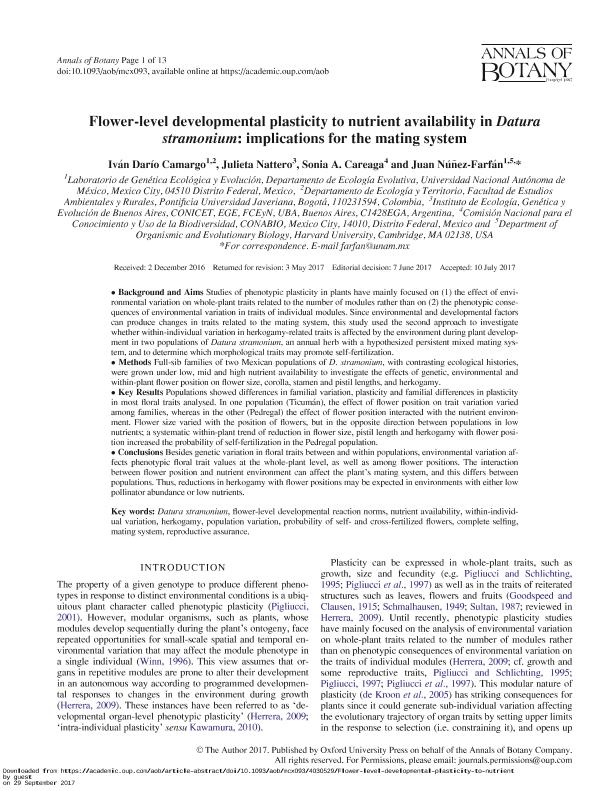Mostrar el registro sencillo del ítem
dc.contributor.author
Camargo, Iván Darió
dc.contributor.author
Nattero, Julieta

dc.contributor.author
Careaga, Sonia A.
dc.contributor.author
Núñez Farfán, Juan
dc.date.available
2018-11-26T15:16:20Z
dc.date.issued
2017-10
dc.identifier.citation
Camargo, Iván Darió; Nattero, Julieta; Careaga, Sonia A.; Núñez Farfán, Juan; Flower-level developmental plasticity to nutrient availability in Datura stramonium: Implications for the mating system; Oxford University Press; Annals of Botany; 120; 4; 10-2017; 603-615
dc.identifier.issn
0305-7364
dc.identifier.uri
http://hdl.handle.net/11336/65143
dc.description.abstract
Background and Aims Studies of phenotypic plasticity in plants have mainly focused on (1) the effect of environmental variation on whole-plant traits related to the number of modules rather than on (2) the phenotypic consequences of environmental variation in traits of individual modules. Since environmental and developmental factors can produce changes in traits related to the mating system, this study used the second approach to investigate whether within-individual variation in herkogamy-related traits is affected by the environment during plant development in two populations of Datura stramonium, an annual herb with a hypothesized persistent mixed mating system, and to determine which morphological traits may promote self-fertilization. Methods Full-sib families of two Mexican populations of D. stramonium, with contrasting ecological histories, were grown under low, mid and high nutrient availability to investigate the effects of genetic, environmental and within-plant flower position on flower size, corolla, stamen and pistil lengths, and herkogamy. Key Results Populations showed differences in familial variation, plasticity and familial differences in plasticity in most floral traits analysed. In one population (Ticuman), the effect of flower position on trait variation varied among families, whereas in the other (Pedregal) the effect of flower position interacted with the nutrient environment. Flower size varied with the position of flowers, but in the opposite direction between populations in low nutrients; a systematic within-plant trend of reduction in flower size, pistil length and herkogamy with flower position increased the probability of self-fertilization in the Pedregal population. Conclusions Besides genetic variation in floral traits between and within populations, environmental variation affects phenotypic floral trait values at the whole-plant level, as well as among flower positions. The interaction between flower position and nutrient environment can affect the plant's mating system, and this differs between populations. Thus, reductions in herkogamy with flower positions may be expected in environments with either low pollinator abundance or low nutrients.
dc.description.abstract
,
dc.format
application/pdf
dc.language.iso
eng
dc.publisher
Oxford University Press

dc.rights
info:eu-repo/semantics/openAccess
dc.rights.uri
https://creativecommons.org/licenses/by-nc-sa/2.5/ar/
dc.subject
Complete Selfing
dc.subject
Datura Stramonium
dc.subject
Flower-Level Developmental Reaction Norms
dc.subject
Herkogamy
dc.subject
Mating System
dc.subject
Nutrient Availability
dc.subject
Population Variation
dc.subject
Probability of Self- A Nd Cross-Fertilized Flowers
dc.subject
Reproductive Assurance.
dc.subject
Within-Individual Variation
dc.subject.classification
Otras Ciencias Biológicas

dc.subject.classification
Ciencias Biológicas

dc.subject.classification
CIENCIAS NATURALES Y EXACTAS

dc.title
Flower-level developmental plasticity to nutrient availability in Datura stramonium: Implications for the mating system
dc.type
info:eu-repo/semantics/article
dc.type
info:ar-repo/semantics/artículo
dc.type
info:eu-repo/semantics/publishedVersion
dc.date.updated
2018-10-23T18:33:51Z
dc.journal.volume
120
dc.journal.number
4
dc.journal.pagination
603-615
dc.journal.pais
Reino Unido

dc.journal.ciudad
Oxford
dc.description.fil
Fil: Camargo, Iván Darió. Universidad Nacional Autónoma de México; México. Pontificia Universidad Javeriana; Colombia
dc.description.fil
Fil: Nattero, Julieta. Consejo Nacional de Investigaciones Científicas y Técnicas. Oficina de Coordinación Administrativa Ciudad Universitaria. Instituto de Ecología, Genética y Evolución de Buenos Aires. Universidad de Buenos Aires. Facultad de Ciencias Exactas y Naturales. Instituto de Ecología, Genética y Evolución de Buenos Aires; Argentina
dc.description.fil
Fil: Careaga, Sonia A.. Comision Nacional para el Conocimiento y Uso de la Biodiversidad; México
dc.description.fil
Fil: Núñez Farfán, Juan. Universidad Nacional Autónoma de México; México. Harvard University; Estados Unidos
dc.journal.title
Annals of Botany

dc.relation.alternativeid
info:eu-repo/semantics/altIdentifier/doi/https://dx.doi.org/10.1093/aob/mcx093
dc.relation.alternativeid
info:eu-repo/semantics/altIdentifier/url/https://academic.oup.com/aob/article/120/4/603/4030529
Archivos asociados
